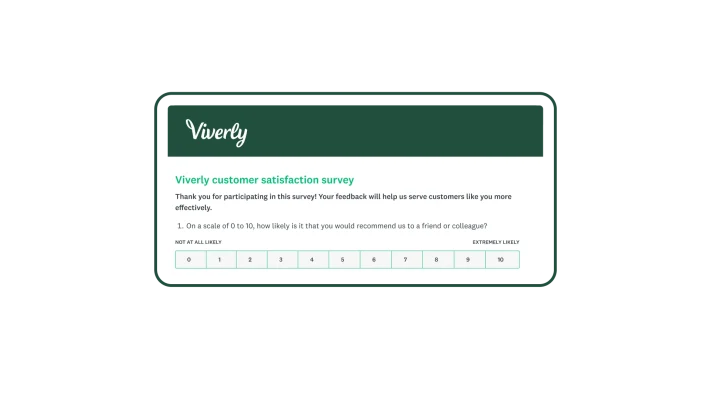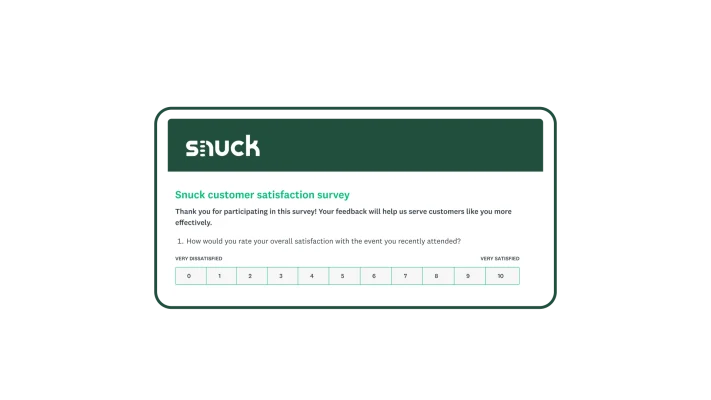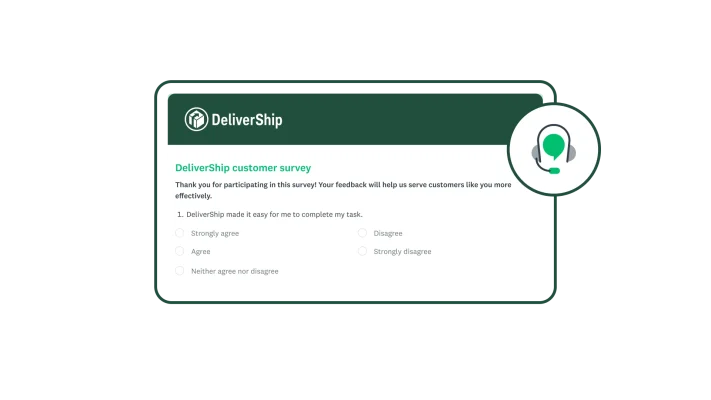How to build a successful Voice of the Customer programme

When was the last time you avoided a brand because of something you had heard or stopped purchasing from a company that had disappointed you?
How often did you get in touch with those businesses to tell them why you won’t be buying from them again?
As someone tasked with improving the customer experience (CX), you can’t expect consumers to seek you out. Instead, you must start the conversation by championing, implementing and maintaining your organisation’s Voice of the Customer (VoC) programme.
What is a Voice of the Customer programme?
Voice of the Customer definition: Voice of the Customer is the systematic collection, analysis and monitoring of customer interactions with your product, service or brand.
A VoC programme is important to your overall customer experience (CX). It’s essentially a commitment to acting upon customer feedback. Your initial goal is to close gaps between customer expectations and your organisation’s performance. When you maintain an effective VoC programme, you’re empowering your employees to exceed customer expectations, too.
Creating a VoC programme vs. collecting customer feedback
Many organisations ask customers for feedback via surveys, feedback forms and focus groups. However, there is more to a Voice of the Customer programme than simply collecting feedback. When you build a VoC programme for your business, you’re making customer engagement, loyalty and satisfaction a core part of your business strategy. A good VoC programme includes:
- Concrete business goals
- Leadership support
- Employee participation and collaboration
- A comprehensive understanding of the customer journey
- Proactive customer listening across channels and touchpoints
- Regular customer and market research
- Data analysis and reporting
- Internal communication
Most importantly, a good VoC programme is actionable. Companies make it a priority to close the customer feedback loop by identifying pain points, resolving issues and communicating these changes to both employees and customers.
Keep reading to learn how to build your own Voice of the Customer programme, from planning to implementation and maintenance. You’ll get tips, key VoC metrics and resources like these Voice of the Customer survey templates to help you get started.
Building your Voice of the Customer programme
1. Gain leadership buy-in and support
Setting up a VoC programme, or even refreshing one you already have, takes time and resources. Before you launch into a full plan, gather the following information and approach leadership to make sure everyone is on board:
- Key customer pain points or concerning metrics (such as a 5% YoY increase in customer churn).
- What a VoC programme is, or how you think your existing VoC programme could be.
- A few case studies from other companies show how important it is to prioritise listening to customers and taking action. An example of this is the time when the Greyhound bus company boosted a key customer loyalty metric by 15 points and made crucial changes to its customer experience, which had an impact on their profitability.
2. Collaborate with key stakeholders to set goals
Once you have leadership on board, collaborate with different teams across the company. Each stakeholder will have a unique perspective on the customer experience and the various methods you can use to improve it.
- Customer success or service teams work directly with customers, understanding key pain points and issues with your product or service.
- Marketing and communications teams will have competitive and market insights. They might also communicate directly with consumers via social media.
- Sales teams will have a good idea of price sensitivity, competing products and solutions as well as which type of messaging works (or doesn’t work) with prospective customers.
- Product teams can help you understand how people interact with your product or service, including data such as churn, error or abandonment rates. They can also help you gain a full understanding of how the products work and any issues or bugs that might be affecting customer satisfaction.
- Human resources or people operations teams can provide details about the employee experience. Are employees engaged? Do they feel empowered to have a positive impact on the customer experience?
Each of these teams might have different goals or ideas of success. To start, you could choose one company-wide goal (e.g. “improve our customer satisfaction rating by 10%”) and encourage each team to set their own goal.
Just remember that this is a customer-centric effort. A product team might want to improve an onboarding experience in order to increase sign-ups. But in the context of a Voice of the Customer programme, it would be better for your product and customer service teams to connect. Customer service could point out key pain points with an onboarding experience and the product team could address these with the goal of reducing the number of customer service tickets.
3. Create a customer journey map
Sit down with key stakeholders to think about how a customer or potential customer interacts with your brand before, during and after their purchase from you. This is called customer journey mapping, and it can help you highlight opportunities to collect feedback, learn more about a particular touchpoint or fill in any gaps in the customer experience. Common customer touchpoints take place before, during and after a purchase. Some examples include:
- Before purchase: advertising, word of mouth, social media
- During purchase: website, store, point of sale
- After purchase: billing, transactional emails, online help centre
When creating your customer journey map, you should also note when, where and how often you ask for customer feedback. This will help you refine your surveys and plan and track them more effectively.
Need help building a customer journey map?
Learn how to create a customer journey map to align stakeholders and achieve your business goals.
4. Listen to customers regularly
When you listen to customers, you’re collecting structured and unstructured (quantitative and qualitative) Voice of the Customer feedback.
Structured data is quantifiable or measurable. For example, let’s suppose you send a survey that asks customers to rate the likelihood of them purchasing from you again. Because you’re asking them to choose from a set of options, the results have a numeric value: 76% of customers say that they would buy your product again.
Unstructured data is qualifiable or immeasurable. For example, in your purchase experience survey, you ask someone to explain why it’s “very likely” that they will buy from you again. You provide a text box so they can tell you more. The text responses that you receive will help you understand the “why” behind the numbers.
To get the full picture of your customer experience, it’s a good idea to collect both data types. Here are some methods you can use to listen to customers regularly as part of an effective Voice of the Customer programme:
- Make sure you’re collecting feedback with customer satisfaction surveys at key customer touchpoints, such as after a purchase or customer service interaction.
- Encourage teams from across the company to meet with the sales and customer service teams, for example, once a quarter.
- Conduct regular customer or user research to gain competitive insights and see where there is room for improvement regarding your product or service.
- Conduct focus groups and customer interviews in order to gain in-depth insights.
- Practise social listening to see how people perceive your brand.
5. Collect key Voice of the Customer metrics
There are a few industry-standard VoC metrics that companies use in order to understand the customer experience. Here are three of the most popular VoC metrics:
Net Promoter Score (NPS)

How likely is it that someone would recommend your company to a friend or colleague? The Net Promoter Score® (NPS) survey gives you a quantifiable, easily trackable answer to this question. Here’s an overview of the NPS survey.
- Simple NPS calculation: Respondents give a rating from 0 to 10 and the resulting score is a number from -100 to +100.
- Trackable and convenient: The Net Promoter Score question is straightforward and versatile, whether you’re asking if someone would recommend your brand or your app or software. The NPS question isn’t tied to a specific event, so it’s a good indicator of how your organisation is performing at any given time.
- Helpful industry benchmarks: Because many organisations use NPS, you can compare your actions against others in your industry. For example, our analysis of hundreds of NPS surveys shows that 38 is the average score for the healthcare industry.
Customer Satisfaction (CSAT) Score

While NPS shows you customer loyalty over time, the Customer Satisfaction Score (CSAT) helps you understand how a customer feels after a specific interaction with your brand. Here’s what you need to know about a CSAT survey:
- Works well with NPS: Both CSAT and NPS are important VoC metrics and give you different, complementary insights into the customer experience.
- Specific and actionable: Use CSAT surveys to make targeted improvements to your customer experience. You can get customer service feedback or measure attendee satisfaction by obtaining their event feedback.
- Easy to calculate and analyse: Answer options in a CSAT survey are based on a numerical scale, such as 1–5. You can look at the raw data, e.g. 478 customers said they were “very satisfied” with their recent customer service interaction, or you can see the data as a percentage.
Customer Effort Score (CES)

How difficult or easy is it for customers to accomplish certain tasks when interacting with your company? The Customer Effort Score (CES) helps you pinpoint major customer friction points, such as when they’re using your software or trying to solve a specific problem. Here’s why you should use CES surveys to enhance your VoC programme.
- Boost customer loyalty: According to our research, 91% of consumers are more likely to recommend a company if they have a low-effort experience.
- Find quick ways to improve: Even an unclear message can cause customers to abandon a purchase. What if changing a few words during the checkout process could have an impact on your bottom line?
- Build better training programmes: You can use CES surveys to understand where your customer service team is underperforming, for example if your representatives are taking too long to resolve customer issues. When you know what’s difficult for your customers, you can tailor your customer service training to resolve common problems faster.
6. Analyse the results
Once you start collecting customer feedback across touchpoints, you must examine each dataset and compare your findings.
- Ask your cross-functional partners to share insights that they’ve gathered from customer and market research, social media channels and more. You’ll need to make all of this information accessible in one place, e.g. an internal wiki or website.
- Some data, such as your Net Promoter Score, is easily understandable at a high level. But if you’re collecting open-ended feedback in your customer surveys, use a text analysis tool to uncover hidden trends.
- You’ll need to slice and dice your survey data using advanced analysis tools such as custom data filters, which can enrich your survey results with deeper customer insights.
7. Take action, maintain and iterate
Once you’ve devised your customer listening strategy, you’ll need to pay attention to – and deal with – any immediate issues, such as a declining NPS or poor customer satisfaction score.
In the long term, you need to create a framework for maintaining a solid VoC programme for your organisation. Here are some ideas.
- Influence product roadmaps: Product teams can commit to fixing one or two pressing customer issues once a quarter.
- Improve customer service training and response: Service teams can prioritise better employee onboarding and empathy training. Alternatively, they can templatise helpful responses to the most frequently asked customer questions, reducing response time.
- Get the whole company involved: Set aside one or two weeks twice a year to focus on resolving customer problems or responding to key customer feedback.
- Keep customers at the heart of your business: Regularly invite customers to tell their stories to employees.
- Share shortcomings and successes: Consider sending a monthly report to company employees highlighting important feedback, data trends and customer stories that will motivate them.
Benefits of a Voice of the Customer programme
When your customers are happy, it’s more likely that they will remain loyal to your brand and recommend you to others. But there are other benefits of Voice of the Customer programme that might not be as obvious.
Improve employee engagement
When you create a Voice of the Customer programme, you’re empowering employees to have a direct impact on the customer experience. You can even encourage teams to set customer-centric goals and reward them for their achievements.
Gain a competitive advantage
A lot of feedback collection is reactive, meaning you’re only able to understand how customers feel after their interaction with your brand. A VoC programme accounts for proactive feedback collection as well. Your findings from focus groups, customer interviews, social media listening and user research can spark opportunities to develop new product ideas, solve consumer pain points and more.
Get even more customer testimonials and social proof
You can use positive customer feedback and interactions to tell powerful stories about your brand across channels, from marketing collateral to your website and social media platforms.
How to overcome some common challenges associated with VoC programmes
Challenge No. 1: Siloed customer feedback and data
Market research, user insights, customer service feedback, social media interactions, survey results: the data work together to provide a full picture of your customer experience. But if the data live in silos, it’s difficult to pick up on trends and highlight important opportunities for action by teams across your organisation.
Make each stakeholder or team responsible for reporting on their findings or sharing it all in one place. You can simplify feedback collection and management with survey integrations for Salesforce, HubSpot, Mailchimp, Zendesk, Zoom and more.
Challenge No. 2: Customers aren’t answering feedback surveys
Are you sending out surveys but not receiving enough responses to ensure statistically significant results? As part of your Voice of the Customer programme, consider a survey audit, whereby you run each survey through a survey best practices checklist.
Customers might be ignoring your surveys if they’re too long or confusing. It’s a good idea to use expert-written survey templates and customer satisfaction survey questions as these will help generate a reliable number of responses.
Still not sure why your surveys aren’t performing well? If so, check out these tips for increasing CSAT response rates and CSAT survey question best practices.
Challenge No. 3: Certain teams aren’t interested in getting on board
If the idea of keeping customers happy isn’t enough to get teams to prioritise resolving customer issues, you need to tie customer satisfaction to revenue. For example, you can showcase the ROI of improving customer satisfaction by tying the lifetime value of a retained customer to the number of people who say that they would buy from you again.
Build your case by sharing compelling research with reluctant teams. Our research shows that 75% of customers lose trust in a business after a poor in-product experience, among other important findings.
5 best practices for how to build a Voice of the Customer programme
Design a VoC programme that captures the pulse of your customer sentiment. Use the following best practices to engage your customers in a dialogue, align your company’s stakeholders and create impactful change.
- Pay attention to implicit data. Implicit data, such as app usage or your churn rate, is the opposite of explicit customer feedback. A customer can tell you they’re satisfied with your app, but if they do not use it again, it’s time to ask more questions.
- Before you start your data analysis, clean up your survey data for the most accurate, actionable results.
- In all likelihood, the happier your employees are, the better your customer experience will be. Work with human resources or people operations to track employee engagement and satisfaction, perhaps with an eNPS survey. You can even monitor and track crucial employee engagement metrics, such as employee NPS, against your customer NPS.
- Put your results in context. Of course, you’re monitoring your customer satisfaction over time. But you’ll also need to benchmark your results against competitors to get a true sense of your performance.
- Make sure your Voice of the Customer programme is up to date. Clue yourself up on the biggest customer experience trends, including how CX professionals are navigating AI and working to meet changing consumer expectations.
Start building your Voice of the Customer programme today
Send a survey in minutes using one of these expert-written Voice of the Customer survey templates. If you’re looking for a little more help, learn how SurveyMonkey can power your VoC programme.
Net Promoter, Net Promoter Score and NPS are trademarks of Satmetrix Systems, Inc., Bain & Company, Inc. and Fred Reichheld.
Discover more resources

Solutions for your role
SurveyMonkey can help you do your job better. Discover how to make a bigger impact with winning strategies, products, experiences and more.

Hornblower enhances global customer experiences
Discover how Hornblower uses SurveyMonkey and powerful AI to make the most of NPS data, collect customer insights and improve customer experiences.

Ultimate customer satisfaction guide: 8 tactics for improvement
What is customer satisfaction? Read our complete guide to discover what customer satisfaction is, how to measure it and eight strategies for business success.

A Guide to the Customer Effort Score (CES): What It Is and How to Use It
Learn how to measure customer satisfaction and experience using the customer effort score (CES). This guide explains what you need to know.